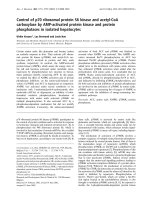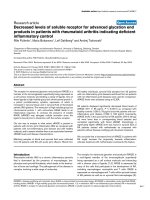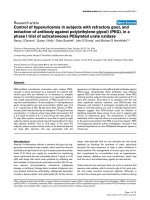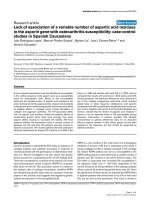Báo cáo y học: "Control of viral replication after cessation of HAART" pdf
Bạn đang xem bản rút gọn của tài liệu. Xem và tải ngay bản đầy đủ của tài liệu tại đây (359.75 KB, 5 trang )
CAS E REP O R T Open Access
Control of viral replication after cessation of
HAART
Ellen Van Gulck
1*
, Leo Heyndrickx
1
, Lotte Bracke
1
, Sandra Coppens
1
, Eric Florence
2
, Anne Buvé
3
, Paul Lewi
4
,
Guido Vanham
1,5
Abstract
We describe two patients who did not experience a viral rebound after cessation of HAART which was initiated for
progressive disease. CD4 T-cell count remained stable in one patient and progressively decl ined in the other,
despite apparent viral control. We failed to identify any immune activation or genetic markers that could offer an
explanation for this unusual “secondary controller” status. But their viruses are clearly less fit compared to viruses
from rebounders.
Introduction
Highly active antiretroviral treatment (HAART) has
improved life expectancy and quality of life of HIV
infected patients [1]. However, so far it is not possible
to “cure” HIV infection mainly because latent reservoirs
persisteveninpatientswhoareoneffectivecombina-
tion treatment [2]. Cessation of HAART results in viral
rebound within days or weeks and pre-treatment levels
ofviralload(VL)aretypically reached within one year
after treatment interruption [3,4].
In 2008 we identified a patient who, after stopping
HAART, had a VL below the detection limit of 1,6log
for more than 2 years. After searching the data base of
1,700 HIV infected patients under follow-up at the clinic
of the Institute of Tropical Medicine, ano ther patient
was identified, who spontaneously controlled VL after
cessation of HAART for at least 6 months. We labeled
these two patients “ secondary controllers” (SC) as
opposed to “elite controllers” (EC) who spontaneously
control viral replication but are treatment naive.
Comparison between SC and “rebounders”
Methods
In order to identify correlates of SC status, we compared
clinical characteristics, viral factors, genetic traits and
immune activation markers in the two SC and patients
who rebound after treatment cessation. We used the
following criteria to define SC and rebounders: (1) being
HIV-1 infected for at least 3 years; (2) HAART started
in the chronic progres sive phase; (3) HAART discontin-
ued for the first time; and (4) VL below the detection
limit of 1.6log at treatment interruption. Pregnant
women taking HAART to pr event mother-to-child
transmission and patients who started treatment in the
acute phase of infection were excluded. SC were defined
as patients who met the above criteria and who kept
their VL below 3log for at least 6 months after treat-
ment cessation. In o rder to make sure that the SC were
not taking antiretroviral drugs, plasma samples were
tested for the presence of protease inhibitors (PI) and
non nucleoside reverse transcriptase inhibitors at the
Bioanalytical Laboratory of the Catholic University of
Louvain.
The following parameters were assessed: HIV su btype,
CD4 count, VL and number of days on HAART and
were compared in SC and rebounders. In addition, we
evaluated plasma markers of immune activation, includ-
ing: neopterin; beta-2 microglobulin (B2M) (Demiditek,
Germany); soluble CD14 (sCD14) (R&D, United King-
dom); and lipopolysaccharide (LPS) (Lonza, Belgium).
These measurements were done on stored plasma sam-
ples taken before starting HAART (T1), during HAART
(T2) and 6 months after stopping HAART (T3). Soluble
markers in plasma were measured instead of activation
markers on cells (Roberts AIDS 2010), because at our
clinic only plasma samples of patients are stored.
In order t o assess viral factors, the SC provided 100
ml of blood for purification of CD4+ T-cells. One part
* Correspondence:
1
Virology unit, Department of Microbiology, Institute of Tropical Medicine,
Antwerp (ITMA), Antwerp, Belgium
Full list of author information is available at the end of the article
Van Gulck et al. AIDS Research and Therapy 2011, 8:6
/>© 2011 Van Gulck et al; licensee BioMed Central Ltd. This is an Open Access arti cle distribu ted under the terms of the Creative
Commons Attribution License ( .0), which permits unrestricted use, distribution, and
reproduction in any medium, provided the original work is properly cited.
was used to extract DNA, as described elsewhere [5], for
sequence analysis of Gag, Pol and Env. The other part
was used to cultivate the virus [6].
In addition, we evaluated the relative replication capa-
cityofP1.Toassessviralfitness phytohemagglutinin
(PHA) stimulated peripheral blood mononuclear cells
(PBMC) from 3 healthy donors were infected at multi-
plicity of infection (MOI) 10
-3
with the viruses, IIIB and
BAL a s reference strains (NIH, Germantown, MD), and
with virus isolated from SC patient 1 and fr om 4 dif fer-
ent rebounders. P24 concentrations were measured by
ELISA over time.
This study was approved by the Institutional Review
Board of ITM and the Ethics Committee of the Univer-
sity Teaching Hospital in Antwerp. Informed consent
was obtained from all patients.
Results
When searching our database on 1700 patients in regu-
lar follow-up, we found that a total of 160 patients had
stopped HAART for the first time, after a mean of 25
months of successful viral s uppression. Treatment wa s
stopped under medical guidance, mostly because of toxi-
city and/or because the patient wanted a drug holiday.
At least two VL measurements after treatment cessation
were available for 124 patients, which enabled us to
classify them as “rebounders” or “ SC”. Median time to
rebound (VL > 3log) was 7 weeks and median time to
re-starting treatment was 4.5 months. Sixty-eight
patients remained off treatment for at least 6 months.
By that time all but 2 patients (the SC) had a VL that
exceeded 3log. Both SC were negative on the drug
assays.
Case presentations
Patient 1 was diagnosed with HIV infection in 1985. In
1993 he started treatment with AZT, when his CD4
count was 228/μL . VL testing was unavailable at that
time and no plasma samples from 1993 were available
at the clinic in Antwerp. The first VL measurement
dated from 1999 when the patient was already taking
AZT monotherapy. It was 3.4 log and a PI based
HAART regimen was started and continued till 2001,
when the patient was switched to Nevirapine and 2
nucleoside reverse transcriptase inhibitors (NRTI’s). He
took this combi nation till treatment interruption in
April 2005, when his CD4 count was 458/μl. In July
2005 the VL was 3.9log but from October 2005 until
now it remained below the detection limit. The CD4
count, however, has been decreasing to 205/μLinFeb-
ruary 2010 but the patient refuses to be restarted on
treatment.
Patient 2 was found to be HIV positive in 1997, but
was probably infected since 1991. In 1998 her CD4
count was 377/μLandherVL4.6log.Shewasstarted
on HAART with a PI based regimen. In 1999 she
switched to Nevirapine and 2 NRTIs. Treatment was
stopped in March 2006. The VL remained undetectable
after treatment interruption, though in April 2009 there
was a blip in the plasma VL of 2,9log, which was
detected with the Cobas ampliprep/cobas Taqman
(Roche, New Jersey, USA). The patient is still off treat-
ment with a stable CD4 count above 1000/μL.
Table 1 summarizes the main clinical findings of the
two SC and the 66 rebounders. All clinical parameters
of SC, including VL before HAART and time on
HAART, were within the range of the rebounders.
Patient 2 carried HLA B3501, which is rather associated
with rapid p rogr essio n. Both SCs were homozygous for
wild type CCR5. They also show similar levels of plasma
immune activation during and after stopping HAART,
as compared to the rebounders.
Virus measured as p24 in cul ture supernatant of puri -
fied CD4+ T-cells from patients under HAART, typi-
cally emerges aft er 3 to 6 days. In contrast, in patient 1
it emerged on day 21, while in patient 2 virus culture
failed despite three attempts. In 2009, however, the lat-
ter patient had a blip in plasma virus suggesting that the
virus is not completely defective. More over the
sequences of Gag, Pol and Env in the two SC did not
show any obvious defects, and no CD8 T-cell associated
escape mutations could be detected. Remarkably, phylo-
genetic analysis of env from patient 1 revealed the pre-
sence of two related but distinct viruses. Both viruses
were lacking the lentivirus lytic peptides (LLP) 1 region,
but could still be cultured.
Autologous viruses from patient 1 could be cultured
making it possible to investigate whether the virus of
this patient was less fit in comparison to reference
strains or v irus of 4 different rebounders. Figure 1
clearly shows that the virus of the SC replicates less as
compared to the reference strains and viruses of
rebounders since the amount of p24 produced in PHA
stimulated PBMC remains much lower over time in
comparison to viruses of r ebounders and the reference
strain.
Discussion
We identified two HIV-1 infected patients with an
exceptional clinical course after stopping HAART. One
patient kept stable and high CD4 T-cell counts for more
than 4 yea rs after treatment cessation, while the other
patient had progressive disease with decreasing CD4 T-
cell counts. Such discrepancy of evolution has also been
described in elite controllers [7-9].
To our knowledge there is only one previous study
that had identified patients who maintained an unde-
tectable viral load for several months after treatment
Van Gulck et al. AIDS Research and Therapy 2011, 8:6
/>Page 2 of 5
Table 1 Comparison between rebounders and secondary controllers
Rebounders (n = 66) Secondary controllers (n = 2)
P1 P2
Sex:
Male 43 M F
Female 23
Age at start HAART (years) 37 (20-61)
a
50
b
45
Clinical parameters of infection
Days since diagnosis 4563 (1529-8469) 7709 4191
Days on HAART 1364 (160-4063) 4257 2860
Days off HAART 541 (182-2468) not restarted not restarted
CD4 at start HAART 292 (23-804) 228 377
CD4 at stop HAART 698 (113-1669) 458 1326
VL before start HAART 4.98 (3.47-6.0) 3.4
(under AZT)
4.6
(treatment naïve)
VL 6 months after stopping HAART 4.69 (3.04-6.0) <1.6 < 1.6
Months with undetectable VL under HAART 25 (1-98) 65 83
HIV-1 subtype
3A B D
17 B
1D
2H
3 CRF_01
4 CRF_02
1 CRF_36
1 CRF_D/F1
34 unknown
Markers of immune activation
sCD14 (ng/ml)
T1 2066 (1682-2380)
c
ND 1648
T2 2032 (1627-2499) 3037 3119
T3 2173 (1744-2740) 4269 1760
LPS (EU/ml)
T1 4.04 (3.02-6.45) ND 7.4
T2 4.17 (3.02-5.8) 3.41 3.36
T3 4.61 (3.41-5.35) 4.31 4.43
Neopterin (nmol/l)
T1 8.15 (4.93-11.61) ND 13.14
T2 18.22 (11.36-25.07) 9.35 17.76
T3 8.75 (5.37-17.1) 5.16 15.03
Beta-2 microglobulin (μg/ml)
T1 448 (346-596) ND 300
T2 252 (226-308) 336 212
T3 466 (344-566) 694 280
HLA types B4101, B5201 B1402, B3501
ND: not done, because no plasma sample was available.
T1 = before start of HAART; T2 = during HAART; T3 = 6 months after treatment cessation:
a
Rebounders: median (min-max).
b
For secondary controllers number is given.
c
Rebounders: median (IQR).
Van Gulck et al. AIDS Research and Therapy 2011, 8:6
/>Page 3 of 5
cessation. Skiest et al mentioned 2 patient s who had an
undetectable viral load for 6 months after treatment was
stopped as part of a study on the effects of treatment
interruption. However, they just mention them without
comparing them with patients whose viral load
rebounded[10].Weareawareofonlyonestudythat
has explored factors predictive of “non- reboun der” sta-
tus [ 11]. Bedimo et al defined non-r ebounders as
patients who had a VL below 3,7log at least 6 months
after treatment interruption while we defined SC as
patients who had a VL below 3log. In Bedimo’s cohort
27% of patients were non-rebounders and peak VL prior
to HAART was predictive of non-r ebounder status. In
contrast, the SC we identified had a VL prior to starting
HAART that was in the range of VL of rebounders
which we defined as having a VL > 3 log 6 months after
HAART cessation. In our study VL before HAART
initiation seemed thus not to be associated with cont rol
of viral replication after treatment cessation.
One possible explanation for the SC status is that
deleterious mutation s have been induced in the virus by
HAART. However, sequencing of the major structural
genes of the 2 available viruses did not reveal any
obvious defects. Virus could be cultivated in patient 1
only, but patient 2 had a spont aneous “in vivo” blip. We
hypothesize that these replication competent viruses are
less fit and/or are kept under control by the patient ’s
immune system. Indeed, as shown in Figure 1, virus
from patient 1 was less fit than the viruses from reboun-
ders and the two reference strains BAL and IIIB. The
fact that the virus from patient 2 could not be cultivated
in vitro under conditions that easily allow virus growth
in all o ther patients is also an implicit proof of lower
fitness.
Markers of immune activation are more disturbed in
patients with rapid progression and closer to normal in
EC [12,13]. Neopterin and b2microglobulinhavealso
been shown to predict disease progression, especially in
late stage HIV-1 infection [14-16]. However, we did not
find any differences between SC and rebounders, in
levels of immune activation before initiating therapy,
during therap y and after t reatment cessation, suggesting
that immune activation does not play a role in SC
status.
Research on EC is very active because these patients
may give clues for novel approaches to the development
of a preventive HIV vaccine. Research on immune func-
tion in the secondary controllers in this study is
ongoing; as we believe that they might provide new
insights about correlates of protection and be useful for
the development of therapeutic vaccines.
Consent
Written informed consent was obtained from the
patients for publication of this case report. A cop y of
the written consent is available for review by the Edit or-
in -chief of this journal.
Acknowledgements
This work was supported by grants from the Fund for Scientific Research
Flanders (FWO) (G.0.370.08.N.10).
Figure 1 Relative replication fitness. The relative replication
fitness was determined in PHA blasts from 3 healthy donors by
measuring the p24 production produced by HIV reference strains
BAL and IIIB or patient viruses (P1 is secondary controller, P5-P8 is
from rebounders). (A): p24 production in ng/ml in donor 1. (B): p24
production in ng/ml in donor 2. (C): p24 production in ng/ml in
donor 3.
Van Gulck et al. AIDS Research and Therapy 2011, 8:6
/>Page 4 of 5
We thank the AIDS reference laboratory (ARL) of our institute for the
collection and anonymisation of samples.
Author details
1
Virology unit, Department of Microbiology, Institute of Tropical Medicine,
Antwerp (ITMA), Antwerp, Belgium.
2
HIV/STD unit, Department of Clinical
Sciences, ITMA, Antwerp, Belgium.
3
STI/HIV Epidemiology and Control Unit,
Department of Microbiology, ITMA, Antwerp, Belgium.
4
Department of
Medicinal Chemistry, University of Antwerp (UA); Faculty of Medicine and
Pharmacy, Free University of Brussels (VUB) and Department of Gynecology
and Obstetrics, Catholic University of Leuven (KUL), Belgium.
5
Department of
Biomedical Sciences, Faculty of Pharmaceutical, Veterinary and Biomedical
Sciences, University of Antwerp and Faculty of Medicine and Pharmacy Free
University of Brussels, Belgium.
Authors’ contributions
EVG performed all culture experiments and ELISAs for immune activation,
contributed to the study design, data analysis and interpretation of the data;
and wrote the paper. LH was responsible for the molecular biological
aspects of this study and performed all sequence analyses. LB: performed
the experiments to investigate the replicative fitness.
SC performed all DNA isolations and amplifications. EF was responsible for
the clinical aspects of the study. He identified the patients, abstracted the
clinical information and recruited the patients in the study. AB contributed
to the study concept, and the writing of the project proposal and the paper.
PL performed all the statistical data analyses. GV supervisor and principal
investigator of the project, contributed to the study design, data analysis
and interpretation of the data. All authors have read and approved the final
manuscript.
Authors’ information
EVG is a postdoc at the Institute of Tropical medicine. During her PhD she
was trying to develop a therapeutic vaccination against HIV based on
dendritic cells electroporated with mRNA encoding HIV Gag. In this studies
patients on HAART were vaccinated with these DC. After vaccination it is the
goal that they stop treatment and control the virus. Therefore these patients
are so special because they can do it without vaccination. If we can find out
why than we know to which parameter we have to look for protection in a
therapeutic vaccination. AB, EF, GV are clinicians. EF is really working in the
clinic and seeing patients. AB and GV are more interested in research. For EF
is it also important if we can unravel why these patients control the virus
after treatment interruption, maybe more patients can go on drug holiday.
Competing interests
The authors declare that they have no competing interests.
Received: 23 August 2010 Accepted: 11 February 2011
Published: 11 February 2011
References
1. Mocroft A, Brettle R, Kirk O, et al: Changes in the cause of death among
HIV positive subjects across Europe: results from the EuroSIDA study.
AIDS 2002, 16:1663-71.
2. Finzi D, Blankson J, Siliciano JD, et al: Latent infection of CD4+ T cells
provides a mechanism for lifelong persistence of HIV-1, even in patients
on effective combination therapy. Nat Med 1999, 5:512-7.
3. Fernandez Guerrero ML, Rivas P, Molina M, Garcia R, de Gorgolas M: Long-
term follow-up of asymptomatic HIV-infected patients who discontinued
antiretroviral therapy. Clin Infect Dis 2005, 41:390-4.
4. Steingrover R, Pogany K, Fernandez GE, et al: HIV-1 viral rebound
dynamics after a single treatment interruption depends on time of
initiation of highly active antiretroviral therapy. AIDS 2008, 22:1583-8.
5. Bailey JR, Williams TM, Siliciano RF, Blankson JN: Maintenance of viral
suppression in HIV-1-infected HLA-B*57+ elite suppressors despite CTL
escape mutations. J Exp Med 2006, 203:1357-69.
6. Chun TW, Carruth L, Finzi D, et al: Quantification of latent tissue reservoirs
and total body viral load in HIV-1 infection. Nature 1997, 387:183-8.
7. Greenough TC, Sullivan JL, Desrosiers RC: Declining CD4 T-cell counts in a
person infected with nef-deleted HIV-1. N Engl J Med 1999, 340:236-7.
8. Hunt PW, Brenchley J, Sinclair E, et al: Relationship between T cell
activation and CD4+ T cell count in HIV-seropositive individuals with
undetectable plasma HIV RNA levels in the absence of therapy. J Infect
Dis 2008, 197:126-33.
9. Madec Y, Boufassa F, Porter K, Meyer L: Spontaneous control of viral load
and CD4 cell count progression among HIV-1 seroconverters. AIDS 2005,
19:2001-7.
10. Skiest DJ, Morrow P, Allen B, et al: It is safe to stop antiretroviral therapy
in patients with preantiretroviral CD4 cell counts >250 cells/microL.
J Acquir Immune Defic Syndr 2004, 37:1351-7.
11. Bedimo R, Chen RY, Westfall AO, Raper JL, Allison JJ, Saag MS: Sustained
HIV viral suppression following treatment interruption: an observational
study. AIDS Res Hum Retroviruses 2006, 22:40-4.
12. Day CL, Kaufmann DE, Kiepiela P, et al: PD-1 expression on HIV-specific T
cells is associated with T-cell exhaustion and disease progression. Nature
2006, 443:350-4.
13. Ondoa P, Dieye TN, Vereecken C,
et al: Evaluation of HIV-1 p24
antigenemia and level of CD8+CD38+ T cells as surrogate markers of
HIV-1 RNA viral load in HIV-1-infected patients in Dakar, Senegal.
J Acquir Immune Defic Syndr 2006, 41:416-24.
14. Fahey JL, Taylor JM, Manna B, et al: Prognostic significance of plasma
markers of immune activation, HIV viral load and CD4 T-cell
measurements. AIDS 1998, 12:1581-90.
15. Roberts L, Passmore JA, Williamson C, et al: Plasma cytokine levels during
acute HIV-1 infection predict HIV disease progression. AIDS 2010,
24:819-31.
16. Zangerle R, Steinhuber S, Sarcletti M, et al: Serum HIV-1 RNA levels
compared to soluble markers of immune activation to predict disease
progression in HIV-1-infected individuals. Int Arch Allergy Immunol 1998,
116:228-39.
doi:10.1186/1742-6405-8-6
Cite this article as: Van Gulck et al.: Control of viral replication after
cessation of HAART. AIDS Research and Therapy 2011 8:6.
Submit your next manuscript to BioMed Central
and take full advantage of:
• Convenient online submission
• Thorough peer review
• No space constraints or color figure charges
• Immediate publication on acceptance
• Inclusion in PubMed, CAS, Scopus and Google Scholar
• Research which is freely available for redistribution
Submit your manuscript at
www.biomedcentral.com/submit
Van Gulck et al. AIDS Research and Therapy 2011, 8:6
/>Page 5 of 5









